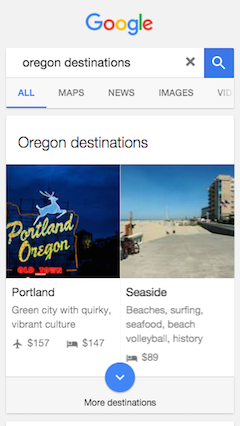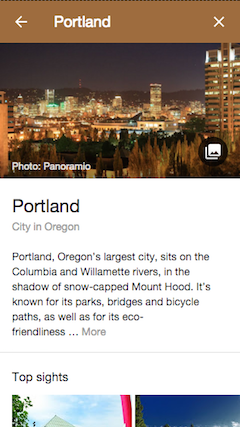In a move that certainly looks like a larger step toward becoming an Online Travel Agency (OTA) the new Google Travel Planner interface for mobile devices aims to keep those users on the search engine throughout the trip planning process. Discover what this new travel planner is and how it will impact the OTA, destination, travel, transportation and lodging markets.
The Google Travel Planner Experience on Mobile Devices
 As noted by hotel ads management company Koddi and digital marketing company HeBS Digital, the travel planner interface is displayed when searching for location plus “where to go”, “destinations”, etc.
As noted by hotel ads management company Koddi and digital marketing company HeBS Digital, the travel planner interface is displayed when searching for location plus “where to go”, “destinations”, etc.
Rather than display the usual ads followed by organic results found on other websites (typically topped by TripAdvisor, Fodor’s or other travel-based sites) as it had in the past, Google attempts to retain the mobile user with its own trip planning interface.
The Landing Page
Search for “where to g o” or “destinations” for a country, a well known region, a state or major city, and Google will display the top two results what it deems as relevant.
o” or “destinations” for a country, a well known region, a state or major city, and Google will display the top two results what it deems as relevant.
These results are neither ads nor organic results. All of what’s displayed for these listings is pulled from Google’s own local data and resources, including:
- A representative photo
- Location name
- Brief summary of location
- Starting price for flights (see airplane icon)
- Starting price for hotel rooms (see bed icon)
If unsatisfied with the results, the mobile user may click “More destinations” for more listings (often many, many more if a state or larger size location search is made).
Results can then be filtered by travel interests, dates, or prices. Travel interest options are tailored somewhat to the destinations. You’ll find “beaches” for Oregon and “desert” for Arizona, for example (even though Oregon has its famous high desert and Arizona has its share of beachfront on Lake Havasu and elsewhere).
The Destination Page
 Choosing Portland for this example, reveals a new page, again populated only by Google’s own material, including:
Choosing Portland for this example, reveals a new page, again populated only by Google’s own material, including:
- Location name
- A different representative photo from Panaromio
- A longer, expandable description of the location
- Top two recommended sites
Further down the page is the section that makes up the travel planning functions of this new Google feature.
Plan a Trip on Google
 Here’s where the mobile user gets to the real focus of this new feature from Google. This section of the destination page displays:
Here’s where the mobile user gets to the real focus of this new feature from Google. This section of the destination page displays:
- A suggested travel date for best value
- Link to Google Flights data showing “starting at” prices
- Link to Google hotels search result showing average price for a 3-star hotel
- Link to Google restaurants search results s
- Google map location of the destination
Following this are sections for “When to visit” (including peak travel dates and climate by month), videos, “Other places to explore”, and, lastly, “See web results”.
What’s Next for Google Travel Panner?
I expect Google will:
- Expand upon it with more medium to large cities getting the same interface treatment for “where to go”-type queries
- Add it to the desktop ex, and eventually
- Evolve the interface to provide a better user experience based on the interactions they track
It’s far too soon to judge how successful this interface will be, but changes, like everything else Google makes, can be expected.
What Google’s OTA Development Means to Lodging Providers
As with last September’s expansion of Google Hotel Ads, this new Google Travel Planner indicates that the search engine giant will continue its march into the Online Travel Agency market and also that it will increasingly rely on commission-based Google Hotel Ads revenue from ads used by its hotel Global Distribution System (GDS) providers rather than Google AdWords. For small & boutique hotels, B&B inns and other unique lodging, this presents a significant reason to:
- Check your competitors to see if they are participating in Google Hotel Ads
- Review your revenue from all online sources, including organic search, referral sites, OTAs such as TripAdvisor, and, especially Cost-Per-Click (CPC) advertising with AdWords and, if you see plateauing or falling returns on those marketing investments,
- Give careful consideration to partnering with a GDS that participates in Book on Google to stay competitive in this evolving trip planning interface for mobile devices
The current list of GDS partners for Book on Google are:
- DerbySoft
- Fastbooking
- Sabre Hospitality Solutions
- Seekda
- TravelClick
- Trust International
Google has stated it will be adding more partners to Google Hotel Ads Commission Program. I will continue to follow news stories on Google Hotel Ads and the Google Travel Planner as they develop.
If you have concerns about your online bookings, contact InsideOut Solutions for an internet marketing review.
